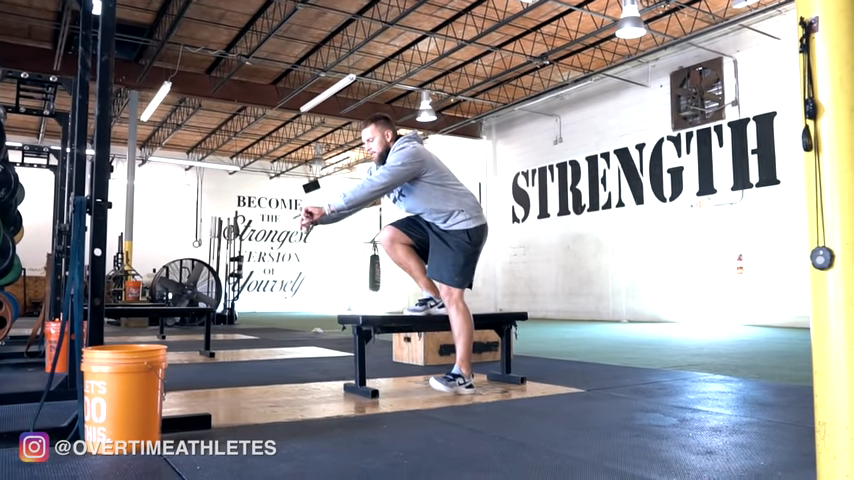How to Program Bodyweight Training for Athletes
This whole virus situation has lasted a lot longer than I anticipated. Athletes are STILL without access to training facilities and gym. The only thing left to do is switch to bodyweight training for athletes.

But, despite the fact that no gyms are open, some athletes still scoff at the idea of bodyweight training.
And that’s fine. I’m not here to convince you of anything…
But, for those of you who want to gain a competitive edge when you don’t have access to a gym, I urge you to implement the following three parameters to enhance your athletic bodyweight training.
Let’s jump into them:
The Goal of Bodyweight Training for Athletes

The goal of bodyweight training for athletes or any kind of athletic training at all is to build movement efficiency.
That means we’re training MOVEMENTS, not muscles. Which also means that weights are nothing more than a tool. They’re not the end all, they just add to the stimulus that we present our bodies with. But, the stimulus from weights is not necessary.
We can make up for that stimulus with other modalities. And the stimulus from these modalities are going to transfer over to your performance on the field, court, or wherever else.
These modalities not only differentiate bodyweight training for athletes from regular old calisthenics… But, they’ll help create an athletic bodyweight training program that is superior to most weighted programs out there.
Bodyweight Training For Athletes Tip #1: Use Resistance

No, I’m not talking about using resistance bands.
Or a weighted vest.
Or those silly k-bands.
I’m talking about using gravity… More specifically, how you can elevate the amount of force you have to absorb by tactfully using gravity.
If you don’t know, the more force your muscles can absorb, the more they can produce. Naturally, with bodyweight training, we want to increase the amount of force your body has to absorb.
As a refresher, your body absorbs force during the eccentric phase of movement. So, as you lower down into a push-up, you’re absorbing force. As you descend into a squat, you’re absorbing force.

And just like you can raise the amount of force your body absorbs by performing a depth drop off of a bench, you can do this with other movements as well.
That doesn’t mean you should jump off your roof.
It means when you’re performing a horizontal push, or squat, or some other movement pattern, drop off of a raised surface to raise the amount of force your body absorbs.
Bodyweight Training for Athletes #2: Use Tempos

Yeah, you knew some talk about tempo training was coming.
But, you probably already know that tempo training is KEY for building elastic strength. And more elastic strength should be one of the goals of a bodyweight training program for athletes, as it’s critical for amplifying your athletic gains.
More than that, training with tempos can lead to more explosiveness by manipulating neuromuscular mechanisms
For example, slow eccentric tempos not only increase the amount of force a muscle can absorb… They also disable GTO inhibition, allowing for harder muscle contractions.

Isometric holds increase motor unit recruitment, which will teach you to use larger, fast-twitch fibers when performing certain movement patterns.
So, whether you’re performing slow, eccentric squats…
Or using an isometric hold at the bottom of a push-up…
Or exploding out of the bottom of a Bulgarian split squat…
Tempos will be monumental for increasing your athletic gains with bodyweight training.
Bodyweight Training for Athletes #3: Volume

If we don’t have access to weights, we’ll have to increase the stimulus applied to our muscles by cranking up the volume.
This will build muscle, AND increase your movement efficiency in certain movement patterns.
It will also, again, teach your body to recruit larger, more explosive muscle fibers and motor units when performing certain movements.
And you will teach your body to call upon those larger motor units when sprinting, jumping, and more.
How to Plug This Into Your Programming

If you’ve seen my posts on programming, you know that I usually start begin my programming with 3-5 explosive movements.
These can be speed mechanics drills, plyometrics, or some kind of ballistic movement.
If you have one of my training programs, you can keep the power section of your training the same.
From there, pick 3-5 bodyweight movements and use the parameters I laid out above.
You can also pair a calisthenic movement with an explosive movement that works the same movement pattern for a variation of contrast training.

And…
If you don’t want to bother with your programming at all… You can take Athletic Calisthenics for a ride.
Athletic Calisthenics is the #1 Athletic Bodyweight Training program around.
And it contains all of the performance-enhancing principles I laid out above, plus a bunch more.
Here’s wha one athlete had to say about Athletic Calisthenics:
“Yo Chris…
Just finished Athletic Calisthenics, and I can say it shattered any doubts I had about the effectiveness of bodyweight training for athletes.
I got leaner, my vertical shot up 5 inches, and I feel like I have springs in my feet.
I’m going to start round two, but wanted you to know that Athletic Calisthenics made me a more powerful athlete.
Thanks again
–Nick from Baltimore, MD”
If you want to join Nick in getting MASSIVE athletic progress at home, head over to the link below:
===>Click Here to Discover How to Increase Your Athleticism At Home
